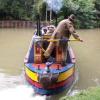-
Posts
275 -
Joined
-
Last visited
About antarmike
- Birthday 09/04/1954
Contact Methods
-
Website URL
http://
Profile Information
-
Gender
Male
-
Location
Horncastle
-
Occupation
Engineer
-
Boat Name
I used to own GUCCCo 118 Bilster
Recent Profile Visitors
3,412 profile views
antarmike's Achievements
Collaborator (5/12)
0
Reputation
-
Granville Galvanised Etching Primer 1 Litre should be about £8.00
-
Would that be M. E. Old Boat-surveyor then ? There does seem to be some confusion on BWB's part since the photo above is of a boat named Kestral not Kestrel. The sign writer, and I use that term loosely, does not seem to be working from any written record or surely the spelling would be correct.
-
The catalogue page I posted says Buck and Hickman, a very famous British engineering supplier with (then) depots in London Glasgow Birmingham Manchester Bristol and Watford. Their only depot in a foreign country in 1971/72 was Dublin, (run by a separate company Messrs Booth, Buck and Hickman Ltd.) My original post had this under the illustration Quote "A bargain at £1.17 in their 1971/72 catalogue". (I would have thought that covered all bases?) Buck and Hickman sell/ sold their own tools under the name "Roebuck". Their older "Roebuck" tool are now collectors items" Buck and Hickman now have 28 Depots throughout the U.K. Buck&Hickman
-
and the Queen's English never made it there either.
-
The page is from the 1971/72 catalogue of Buck and Hickman and if you look at it you can clearly see it is in Pounds and New Pence. Dual pricing for some items was in place in 1970, high denomination Decimal postage stamps were issued in 17th June 1970. British Railways and London Transport went decimal the day before the rest of the country on the 14th February 1971 but all other bus companies did not go metric until Sunday 21st February. Old money could be offered in payment after 15th February, but none was given out in change. On 31 August 1971, the Old penny and the Old threepence had become very rare and the last were officially withdrawn from circulation, ending the transition period. In reality there were several D Days. However the price of the large bucket in this catalogue was 94 New Pence.
-
Amazing how there is no tar staining inside though isn't it! If you look at my catalogue page I posted you will see to the right of the "Boiler Filler" what a hot tar bucket looks like and that is nothing like this! (The tar will cool and solidify in the narrow spout, that is why a Tar Bucket has an open jug like form, Bitumen is put into the bucket in solid blocks, that is why a tar bucket has a completely open top. This is half covered, how can you put big lumps of solid material inside this to melt?)
-
Still being sold in the early seventies (although slightly different design in the tipping handle design), by Buck and Hickman as "Boiler Fillers" Steam engines had a conveniently placed 2" B.S.P. plug that could be removed to pour water into a drained down boiler. As steam traction came to an end it appears the same useful Galvanised filling can was still available under the old name whilst now being used to fill internal combustion engine radiators. A bargain at £1.17 in their 1971/72 catalogue There were two LTE's the first LTE operated between 1948-1962 when On 1 January 1948, under the provisions of the Transport Act 1947 the London Passenger Transport Board was nationalised and renamed the London Transport Executive. I note that from 1948 this LTE started work on the electrification of those parts of the underground network that were still steam operated as soon as they came into existence. On the Central line steam locomotives were still operating between Greenford and West Ruislip in the west and between Leytonstone and Ongar in the east. Electrification to West Ruislip was completed in 1948, leading to the start of passenger trains which did not require locomotive changes on 21 November of that year. On the same day electrification round the "Fairlop loop" in the east was completed. And from 25 September 1949 electric tube trains were in operation between Loughton and Epping. This left a steam shuttle service operating between Epping and Ongar which was not electrified until 18 November 1957. Steam locomotives were fully withdrawn from the Underground network on 9 September 1961. I suppose it is just conceivable that the LTE commissioned new Boiler Fillers with their initials on even though they were working hard to replace steam. This seems unlikely, I reckon this is for filling radiators. (Farmer might fill a traction engine with a can, but surely a steam shed would have hoses!) If radiator filling is the use of this can then the second LTE, again standing for The 'London Transport Executive , but this time the title of the arm of the Greater London Council that ran public transport in London between 1970 and 1984, was a likely candidate for buying these to top up bus radiators. The second LTE was a totally separate organisation to the first.
-
Water not oil, There was one similar always under the water tap at London Transport's/ London Country's Garage in Tring, I often saw drivers topping up from it. The Tap was right beside the road, in front of the office. The can may be seen under the tap which is partially hidden behind the balding gent, the can being just to his right. He is actually standing on the pavement of Western Road. Though it was the unpressurised AEC Regent III's resting in the garage that where more likely to need topping up than this pressurised AEC Merlin/Strachan XMB15. I am surprised the can was never stolen.
-
Look like dredging boats to me, a lot of those were between 10 and 12 foot wide, are we sure these are 14 footers?
-
Interesting to see how the "posts" for the windlass winch attach to the knees. I am sure I would have been into the fore end of Perseverence and Speedweel but I don't remember this detail
-
Thought you might like this Wey Barge Reliance
-
Stern of the Barge ahead of the narrow boat looks more like Tuba/ Gwendoline, which has a smaller Transom than the William Stevens Barges I knew (Perseverance and Speedwell) When I knew Gwendoline/ Tuba she had lost a windlass (If she ever had one). Fleet/ Lightning 2 had a windlass, but she had a sternpost rather than a transom stern, When I knew her she had no foredeck, rather an open Cockpit. (In my opinion she was once decked and this has been lost in the conversion process.) What is clear was, as with Narrow boat design, there was a lot of variation in the designs of the Wey barges. Well Fleet still had the two posts between which her winch /windlass would have fitted. Looking again no fore deck might be as she was built after all, but then again where would the anchore lay and where would the anchor chain be stored?. I am sorry I can't be rsed to sort out these half frame negatives so that you don't get the odd upside down shot!
-
Wey barge passing under "High Bridge" on Tring Summit, My Copyright Detail of Windlass, Anchor and chain
-
Height of the coping stones/ top of the Dock wall/ Quayside suggests Tidal. or on a river prone to flooding, dunno River Wey Barge/ Barges??
-
The boat was around in my time and I remember it as as Ben Cruachen.





